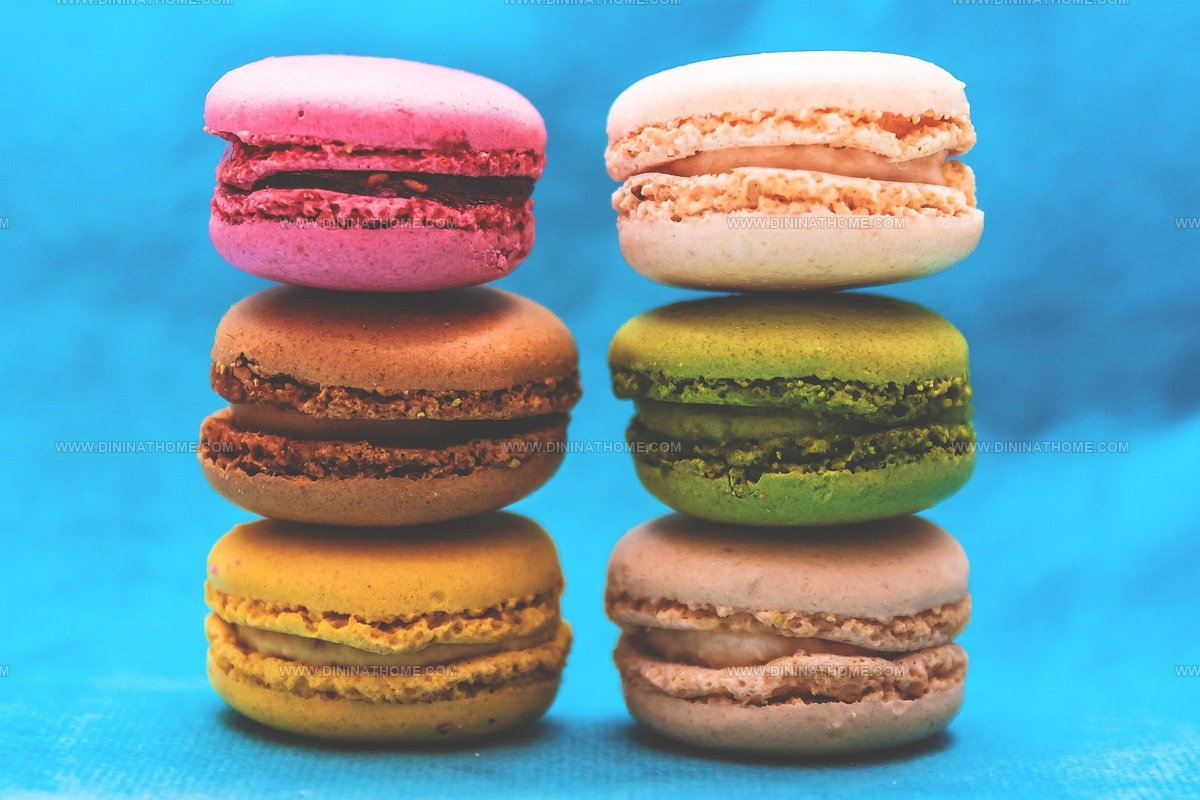What Does A Macaron Taste Like? Bite into Heaven’s Sweet Cloud
French macarons have captivated dessert lovers worldwide with their delicate, colorful appearance.
Crafted with precision and artistic flair, they represent more than just a simple sweet treat.
Professional pastry chefs consider them a culinary masterpiece that requires exceptional skill to create perfectly.
Each macaron combines a crisp outer shell with a soft, creamy interior that promises a sensory experience beyond ordinary cookies.
The subtle nuances of texture and flavor make these delicate confections a gourmet delicacy that sparks curiosity.
Unlike typical desserts, macarons offer a complex taste journey that goes far beyond basic sweetness.
Let's uncover the delightful world of macaron flavors that await you.
What Is a Macaron?
Macaron cookies combine almond flour, egg whites, powdered sugar, and food coloring into a delicate meringue-based treat.
People often fill these small sweets with buttercream, ganache, or fruit jam.
Round cookie shells show off special details like smooth surfaces, ruffly sides (called the crown, foot, or pied), and flat bases.
These light cookies feel soft inside with a slight cake-like chew.
Well-made macarons melt smoothly in your mouth when you bite into them.
Macaron Flavor Guide
Sweet macarons delight taste buds with their mellow flavor.
Popular choices include almond, vanilla, and pistachio varieties.
Classic almond remains a favorite, but bakers create many exciting options.
People can explore different tastes to find their perfect match.
Ground almonds bring a special touch to these delicate treats.
Basic macaron flavor starts with sweetness and subtle nuttiness.
Bakers experiment with exciting combinations like salted caramel, rich chocolate, fruity options, and nutty pistachio.
Balancing extra flavors with natural sweetness makes a macaron truly special.
Each ingredient plays a key role in creating perfect taste and texture.
Macaron Flavors: Classic vs. Modern Varieties
Macarons come in a rainbow of flavors, with both classic and modern varieties bringing their own charm to this delicate French treat:
Classic Flavors
Traditional macarons usually feature simple, timeless tastes like vanilla, chocolate, coffee, pistachio, raspberry, lemon, or salted caramel.
These flavors highlight the macaron’s light texture and sweet almond notes.
Modern Varieties
Bakers today get creative with bold flavors such as matcha green tea, Earl Grey, lavender, yuzu, passion fruit, birthday cake, red velvet, and even savory options like truffle or goat cheese.
Modern macarons may include playful fillings, colorful swirls, or unexpected twists.
Classic macarons offer comfort and elegance, while modern varieties bring excitement and surprise, giving you plenty of options whether you love tradition or crave something new.
French vs. Italian Macarons: Taste and Texture Differences
French and Italian macarons may look alike, but they have some key differences in taste and texture that set them apart:
French Macarons
These are made by whipping egg whites with sugar, then folding in almond flour and powdered sugar.
The shells are light, delicate, and slightly chewy with a crisp outside.
French macarons often have a subtle almond flavor and a gentle sweetness that lets the filling shine.
Italian Macarons
This version uses a cooked sugar syrup mixed into whipped egg whites, making the batter thicker and the shells sturdier. Italian macarons are a bit chewier, with a smoother surface and a slightly more candy-like sweetness.
Macaron Texture Description
A perfect macaron has a texture that feels light and delicate when you bite into it, with smooth shells that are crisp on the outside but give way to a gentle, slightly chewy center.
The inside should feel moist and creamy, not sticky, wet, or crumbly, while the filling must be just thick enough to hold its shape without leaking.
Macaron shells need to be strong enough to avoid collapsing but never hard or dry, and the sweetness should be balanced so the flavors shine through without being overpowering.
Every part, from the airy shell to the smooth, subtle filling, works together for a soft, pleasant chew that makes each bite memorable and satisfying.
Pairing Macarons with Beverages
Pairing macarons with the right drink can make their delicate flavors stand out even more, turning a simple treat into something extra special:
Why Are Macarons Expensive?
Sweet sandwich cookies called macarons have become something special in dessert circles.
People love them for how pretty they look and how amazing they taste.
These little treats cost a lot of money.
Making macarons takes serious skill.
Bakers need special tools, good ingredients, plenty of practice, and tons of patience to create perfect batches!
Macarons aren't just popular by chance.
People have enjoyed these delicate cookies for hundreds of years.
Recently, American shops have started paying more attention to them.
Small bakeries, cute cafes, and dessert stores are now serving these special treats.
People want these colorful cookies more and more.
Are Macarons Healthy Snacks?
Bite-sized treats pack more than just great taste.
Nutty almonds mix with sweet sugar and fluffy egg whites to create something special.
Coconut Macaroons bring a boost of natural energy that helps people stay active and strong.
People who want extra stamina during workouts or daily activities might enjoy this small snack that supports physical strength and endurance.
How Are Macarons Made?
French and Italian methods are two main ways to make macarons.
Making meringue differs between these approaches.
French technique involves whisking egg whites until stiff peaks form.
Sifted ground almonds and powdered sugar mix gradually to reach perfect texture.
Macaronage describes beating out air and folding carefully.
Italian method mixes egg whites with heated sugar syrup to create meringue.
Sifted almonds and icing sugar combine with raw egg whites to form a paste.
Macaron mixture happens when meringue meets almond paste.
People find this method more stable, but much sweeter and it needs a candy thermometer for sugar syrup.
Ground almonds work with both Italian and French meringue styles.
Macarons start with finely ground almonds and icing sugar mixed smoothly.
Egg whites whip up in a separate bowl until they look like meringue.
Bakers fold two parts together until mixture looks like shaving foam, then pipe and bake with a thin skin.
Fillings often complete these delicate treats.
Are Macarons Gluten-Free?
Macarons come without gluten!
These sweet treats naturally skip wheat ingredients during their creation.
Specific macaron kinds might sneak wheat into their recipe through additional mix-ins or special fillings.
People could encounter problems with gluten when bakers add certain ingredients.
One example shows how something like graham cracker pieces sprinkled on meringue cookies can change their gluten status.
Such actions make what started as a safe dessert become unsafe for people avoiding wheat.
Shoppers should watch carefully for unexpected wheat sources when selecting these delicate cookies.
Are Macarons Dairy-Free?
Macarons don't include dairy in their basic recipe, with dairy being added through buttercream made from butter and milk.
People can make dairy-free fillings when baking macarons from scratch.
Macaron shells themselves are dairy-free and made from meringue.
Are Macarons Vegan?
Macarons contain dairy in their filling between two meringue shells.
Both meringue cookies and filling include dairy products.
Vegan macaron recipes often suggest using aquafaba, which comes from canned chickpea liquid.
Personal attempts at making these treats resulted in multiple failures.
Shell sides would burst open during baking, and bottom surfaces became completely charred.
How to Store Macarons
Macarons need special care to stay delicious and keep their perfect texture.
Saving these sweet treats requires some smart steps.
People can keep macarons fresh in different ways.
Refrigerators work best for storing these delicate cookies.
Macarons stay good for one week when left out and can last up to seven weeks inside cold storage.
Their shelf life makes them a wonderful dessert to prepare ahead of time.
Protecting macarons from air matters most when storing them.
Room temperature storage works well with sealed plastic containers that block extra moisture.
Keeping these containers tightly closed helps prevent the cookies from getting dry or losing their special feel.
Refrigerator storage needs similar attention.
Plastic containers help shield macarons from unwanted air exposure.
Careful storage matters if you want to enjoy these treats later in the week or save them for a special moment.
Protecting the texture of macarons takes some extra care.
Making sure they stay crisp and delicate requires paying attention to how and where you store them.
Smart storage means you can enjoy these sweet treats at their very best.


James Walker
Lead Recipe Developer & Culinary Educator
Expertise
Southern Cuisine & Farm-to-Table Cooking, Recipe Development & Testing, Culinary Education & Instruction
Education
School: Auguste Escoffier School of Culinary Arts
Program: Diploma in Culinary Arts and Operations
Focus: Comprehensive training in classical and modern culinary techniques, kitchen operations, and farm-to-table practices.
James didn’t learn cooking from a TV show, he learned it from busy kitchens, family gatherings, and long afternoons spent testing recipes the hard way.
After training at the Auguste Escoffier School of Culinary Arts, he brought his love for real, down-to-earth food to every dish he makes.
At Dining At Home, James loves building recipes that feel familiar but still have something special, like adding a twist to a classic or making a slow Sunday dinner feel brand new.
When he’s not in the kitchen, you’ll probably find him swapping garden tips at the farmers’ market or teaching his daughter how to flip pancakes without a mess (almost).